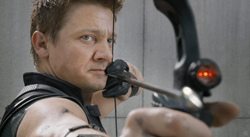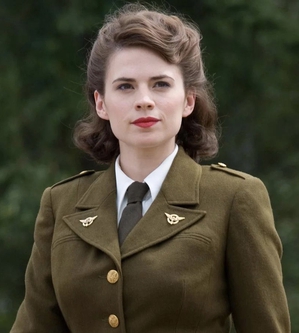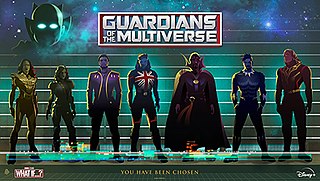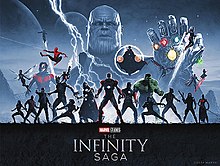
The Marvel Cinematic Universe (MCU) is an American media franchise and shared universe centered on a series of superhero films produced by Marvel Studios. The films are based on characters that appear in American comic books published by Marvel Comics. The franchise also includes television series, short films, digital series, and literature. The shared universe, much like the original Marvel Universe in comic books, was established by crossing over common plot elements, settings, cast, and characters.
The Infinity Stones are fictional items in the Marvel Cinematic Universe (MCU) media franchise, based on the Infinity Gems of the Marvel Comics. As expounded across several interwoven MCU multimedia titles, the six Infinity Stones are reputed to embody and control essential aspects of existence—Space, Mind, Reality, Power, Time and Soul—thereby making them critical artifacts in the MCU and, together, the MacGuffin of the dedicated Infinity Saga.

Natalia Alianovna Romanoff, more commonly known as Natasha Romanoff, is a fictional character primarily portrayed by Scarlett Johansson in the Marvel Cinematic Universe (MCU) media franchise—based on the Marvel Comics character of the same name—sometimes known by her alias, Black Widow. Romanoff is depicted as an expert spy and hand-to-hand combatant, trained in the Red Room from childhood to be a KGB assassin. This brought her under S.H.I.E.L.D.'s radar, and Clint Barton is sent to kill her but instead spared her life and recruited her into the organization.

Thor Odinson is a fictional character portrayed by Chris Hemsworth in the Marvel Cinematic Universe (MCU) media franchise, based on the Marvel Comics character of the same name and the Norse mythological god of thunder. In the MCU, he is depicted as one of the most powerful Asgardians, an ancient alien civilization with long ties to Earth, who humans consider to be gods. Thor wields a powerful hammer called Mjolnir, and is initially depicted as the arrogant heir to the throne of Asgard whose brash behaviors causes turmoil among the Nine Realms under Asgard's protection. This brings him into conflict with his villainous adopted brother, Loki, the god of mischief.

Steven Grant Rogers is a superhero primarily portrayed by Chris Evans in the Marvel Cinematic Universe (MCU) media franchise—based on the Marvel Comics character of the same name—commonly known by his alias, Captain America. Rogers is depicted as a World War II-era super soldier who was given a serum that provided him with superhuman abilities including enhanced durability, strength, and athleticism. During his fight against the Nazi secret organization Hydra, he became frozen in the Arctic for nearly seventy years until being revived in the 21st century.

Avengers Campus is a Marvel Cinematic Universe (MCU)–themed area located at Disney California Adventure and Walt Disney Studios Park in Disneyland Paris, and being developed for Hong Kong Disneyland under the name Stark Expo. The Marvel-themed areas or "lands" are being developed simultaneously at the three parks and inspired by the MCU. However, they instead take place in the "Marvel Theme Park Universe", an alternate universe parallel to it within the MCU multiverse, in which the Blip, introduced in Avengers: Infinity War (2018), and subsequent events did not occur. They are designed by Walt Disney Imagineering, in collaboration with Marvel Studios and Marvel Themed Entertainment.

Clinton Francis Barton is a fictional character portrayed by Jeremy Renner in the Marvel Cinematic Universe (MCU) media franchise—based on the Marvel Comics character of the same name—more commonly known by his alias, Hawkeye. Barton is depicted as an expert marksman, archer and hand-to-hand combatant, with his preferred weapon being a recurve bow. Barton, an agent of S.H.I.E.L.D., is sent to kill Natasha Romanoff but decides to recruit and befriend her instead.

Nicholas Joseph Fury is a fictional character portrayed by Samuel L. Jackson in the Marvel Cinematic Universe (MCU) media franchise, based on the Marvel Comics character of the same name. Prior to the formation of the MCU, Marvel Comics incorporated Jackson's likeness into the reimagined design of the character for The Ultimates. In the MCU, Fury is initially depicted as a master spy who is the Director of S.H.I.E.L.D.. Fury enacts the Avengers Initiative in response to Loki's invasion of Earth, a plan he previously developed after meeting Carol Danvers and learning of extraterrestrial threats.

Margaret "Peggy" Carter, also known as Agent Carter, is a fictional character in the Marvel Cinematic Universe (MCU) media franchise portrayed by Hayley Atwell, based on the Marvel Comics character of the same name. Carter is depicted as a British MI6 agent and member of the Strategic Scientific Reserve who became the love interest of Steve Rogers during World War II. Following the war, she goes on to become one of the founders of S.H.I.E.L.D., eventually serving as the Director. Atwell has received critical praise for her depiction of the character.

The Avengers are a team of fictional superheroes and the protagonists of the Marvel Cinematic Universe (MCU) media franchise, based on the Marvel Comics team of the same name created by Stan Lee and Jack Kirby in 1963. Founded by S.H.I.E.L.D. Director Nick Fury, the team is a United States-based organization composed primarily of superpowered and gifted individuals, described as "Earth's Mightiest Heroes", who are committed to the world's protection from a variety of threats. The Avengers are depicted as operating in the state of New York: originally from the Avengers Tower in Midtown Manhattan and subsequently in the Avengers Compound in Upstate New York. Arranged as an ensemble of core MCU characters originally consisting of Tony Stark / Iron Man, Steve Rogers / Captain America, Thor, Bruce Banner / Hulk, Natasha Romanoff / Black Widow, and Clint Barton / Hawkeye, it later expands to include 16 total members. Regarded as an important part of the franchise, they are central to the MCU's first 23 films, collectively known as the Infinity Saga. The Avengers from alternate universes were depicted in subsequent MCU properties across the Multiverse Saga, including appearances in the Disney+ animated series What If...? (2021–present) and Doctor Strange in the Multiverse of Madness (2022). The Avengers are set to return in Avengers 5 (2026) and Avengers: Secret Wars (2027). Both films will be part of the MCU's Phase Six, concluding the Multiverse Saga.

Marvel Studios: Legends is an American television docuseries created for the streaming service Disney+, based on the Marvel Comics characters and objects that appear in the Marvel Cinematic Universe (MCU). Produced by Marvel Studios, each episode showcases an individual character or object with footage from past MCU films and Disney+ series, highlighting their prominent moments from the MCU.
The Marvel Cinematic Universe (MCU) media franchise features many fictional elements including locations, weapons, and artifacts. While many of these features are based on elements that originally appeared in the American comic books published by Marvel Comics, some features were created specifically for the MCU.

Nebula is a fictional character in the Marvel Cinematic Universe (MCU) media franchise, portrayed by Karen Gillan, based on the Marvel Comics character of the same name. She is depicted as a blue-skinned alien warrior who is both the adoptive daughter of Thanos, who killed her blood family before raising her, and the adoptive sister of Gamora, with whom she grew to share a bitter rivalry. Although she is first introduced as the secondary antagonist of Guardians of the Galaxy (2014), subsequent films see her develop into an antihero and eventually a protagonist, who joins her sister as part of the Guardians of the Galaxy and becomes a member of the Avengers and then officially of the Guardians of the Galaxy. Aspects of this interpretation were later integrated into the comics version of the character.
The Marvel Cinematic Universe (MCU) is an American media franchise and shared universe centered on superhero films/other series starring various titular superheroes independently produced by Marvel Studios: based on characters that appear in American comic books published by Marvel Comics. The shared universe, much like the original Marvel Universe in comic books, was established by crossing over common plot elements, settings, cast, and characters. Due to the galaxy-spanning nature of the franchise, multiple different species have been introduced.
The Marvel Cinematic Universe (MCU) is an American media franchise and shared universe centered on superhero films and other series starring various titular superheroes independently produced by Marvel Studios and based on characters that appear in American comic books published by Marvel Comics. The shared universe, much like the original Marvel Universe in comic books, was established by crossing over common plot elements, settings, cast, and characters. Over the course of the films and related media, several teams and organizations have been formed, each with different aims and purposes.

"What If... the World Lost Its Mightiest Heroes?" is the third episode of the first season of the American animated television series What If...?, based on the Marvel Comics series of the same name. It explores what would happen if the events of the Marvel Cinematic Universe (MCU) tie-in comic Fury's Big Week (2012) occurred differently, with Nick Fury's campaign to recruit the Avengers derailed by a string of deaths. The episode was written by head writer A. C. Bradley and story editor Matthew Chauncey, and directed by Bryan Andrews.

"What If... the Watcher Broke His Oath?" is the ninth episode and season finale of the first season of the American animated television series What If...?, based on the Marvel Comics series of the same name. It continues the previous episode's story, featuring the Watcher and Doctor Strange Supreme recruiting various heroes from parallel realities to fight against an alternate version of Ultron. The episode was written by head writer A. C. Bradley and directed by Bryan Andrews.

The multiverse is a fictional setting within the Marvel Cinematic Universe (MCU) media franchise. Based on the setting of the same name from the Marvel Comics, it is a collection of infinitely many alternate realities and dimensions. First explored in the film Doctor Strange (2016), it is revisited in the film Avengers: Endgame (2019) before playing a key role in Phase Four, Phase Five, and Phase Six of the franchise, which constitute "The Multiverse Saga". The MCU's Multiverse centers around a single universe called the "Sacred Timeline", which the Time Variance Authority (TVA) works to prevent any branching universes from forming. Following the death of "He Who Remains", the Timeline's secret overseer at the hands of Sylvie, the Multiverse is freed and an infinite number of universes are formed. This leads to a variant of Loki from 2012 taking his place.














